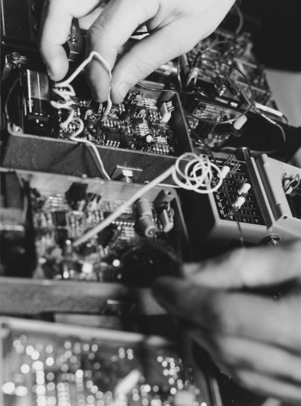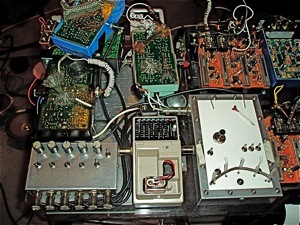
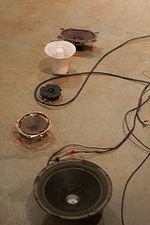 I made my electronic instrument from the exposed circuit boards of consumer-grade electronics that were intended to be used to modify existing sounds. I directly misuse these signal processors by using them to generate sounds themselves rather than change existing ones. This is done by electronically feeding the unit back on itself; on some units I simply connect an input to an output and on others I connect the input directly to the exposed circuit board itself. I also arrange conductive objects on the circuit boards, creating active circuits and sounds that are always difficult or impossible to recreate or retain. I have learned to do this very simple process by trial and error and do not offer myself as someone who is particularly adept at building electronic things. I have done absolutely no re-wiring of the circuits. From the standpoint of technology, the instrument is very simple.
I made my electronic instrument from the exposed circuit boards of consumer-grade electronics that were intended to be used to modify existing sounds. I directly misuse these signal processors by using them to generate sounds themselves rather than change existing ones. This is done by electronically feeding the unit back on itself; on some units I simply connect an input to an output and on others I connect the input directly to the exposed circuit board itself. I also arrange conductive objects on the circuit boards, creating active circuits and sounds that are always difficult or impossible to recreate or retain. I have learned to do this very simple process by trial and error and do not offer myself as someone who is particularly adept at building electronic things. I have done absolutely no re-wiring of the circuits. From the standpoint of technology, the instrument is very simple.
Vic Rawlings – open electronics from Mike Bullock on Vimeo.
The other half of the electronic instrument is the part that is actually heard; the speakers. I wrote an article on this part of the instrument for Leonardo Music Journal a few years ago. Here is a slightly expanded version of that article:
Boss GE-7 E.Q. and Flexible Speaker Array as Tonal Filters
As an improviser using electronics, the most crucial element of music/ sound to me is tone. Tonal filtration by use of equalization and a flexible speaker array is the only sort of signal processing I am interested in because it leaves no residue on the source signal and is most effective at revealing unforeseen aspects of that signal. The source materials I use are pure cracked electronic squeal. These sounds have a harsh, immediate, and unpredictable character that I do not want to smooth-over. My use of a flexible speaker array as a tonal filter coupled with extreme jump-cut use of a Boss GE-7 E.Q. serves to intensify the tonal characteristics and compositional relevance of my source material. There is an indeterminate aspect to the source material that is amplified by the indeterminate aspects of the tonal filters.
Gunter Muller inspired me to use the GE-7. When I asked him what made his rig work he pointed to the equalizer pedal and smiled, so I immediately stole the idea. I liked that he could change the character of a sound fundamentally and simultaneously retain the essence of it. It made it possible for him to use a very limited amount of source material and present a full compliment of sounds that were highly integrated with each other.
I almost exclusively form non-linear patterns on the 7 bands of the GE-7. I most often opt for spiking a certain band or two while allowing the rest to hover near the bottom of their travel. The goal is to allow sounds to become more immediately visible, as in macro-photography. The bypass switch on the E.Q. pedal is also an essential compositional tool. I favor distinct sounds and jump cuts and thus rarely adjust the unit while the circuit is active in the signal path.
My interest in building a flexible speaker array was inspired by an art piece by Jess Goddard. Her piece allowed a person encountering it to switch between several near-identical speakers that had been prepared by being either filled with plaster, smeared with epoxy, or having been treated in a similar extreme way. I switched them on and off and enjoyed being surprised at the unpredictable and extremely different tones that each had- they were singular tones.
When I built my own speaker array to use in performance with my cracked electronics gear I bought a ready-made switch. It was manufactured by a company named Speco and was 35 dollars. It came with 5 selector buttons that could activate any number of 5 pairs of speakers at a time. I took it from its housing and added a master on/ off switch (the most important single element of the entire instrument- silence at one switch) and a series of jacks for the speaker-level input and the speaker outputs themselves. I wired only to the left channel of the stereo pairs. I send a mono signal to any number of up to 5 outputs.
For the array itself I remove speaker drivers from their cabinetry and place them directly on the floor. I like the immediate visual presence of the drivers themselves and feel more connected to the sounds they are making as I see them vibrate and pulse. I choose individual speakers for their idiosyncratic characteristics and aim to form a grouping of complimentary voices. Each speaker must realize the signal in a profoundly individualized manner or it will be redundant. The most valued ones are damaged in such a way as to add a further characteristic acoustic quality to the sound- a rattle or buzz that comes from fatigue or accumulated abuse. These direct tonal filters (the last in the signal line) provide extreme immediacy to the sounds they produce. There is no effect box or modeling device attempting to simulate something known and definitely no default “clean” setting.
I choose to be constantly blindsided by sounds that, were they available as presets, I likely wouldn’t elect to use them at a given moment. As it is, when I select speakers or blindly adjust the E.Q. I am almost always genuinely surprised by the results. By the time I know what the result of a given action will be, it is already undeniably present in the composition. These tonal filters, by virtue of their unpredictable effect, enhance the dynamic aspect of my playing.

This is the instrument I recently made smaller by shrinking the speaker switch (that big white box at the right)
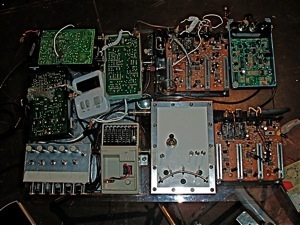
The new speaker switch is the white box at lower right center. The silver box at lower left is the line mixer. This was taken after a show sometime in 2008.
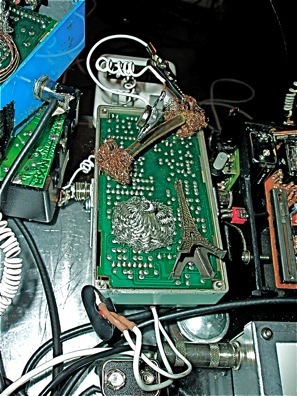
This picture was taken after a performance. The sounds are different with the slightest movement of any one of the metal objects.
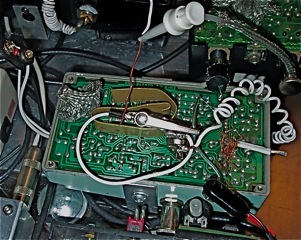
At another show the same box ended up looking like this. I do not follow a set approach to creating sounds. My experience with the circuits I am using informs my actions, but given the unpredictability of the circuits and the impossibility of exactly recreating a circuit I move things around until they make the sound I need at a given moment. That sound will be impossible to preserve.

This is an older arrangement- many of the same units are still in play, but not all of them. I retire boxes that don’t make the sorts of sounds I’m looking for, either because they burn out electrically or because my tastes change.
